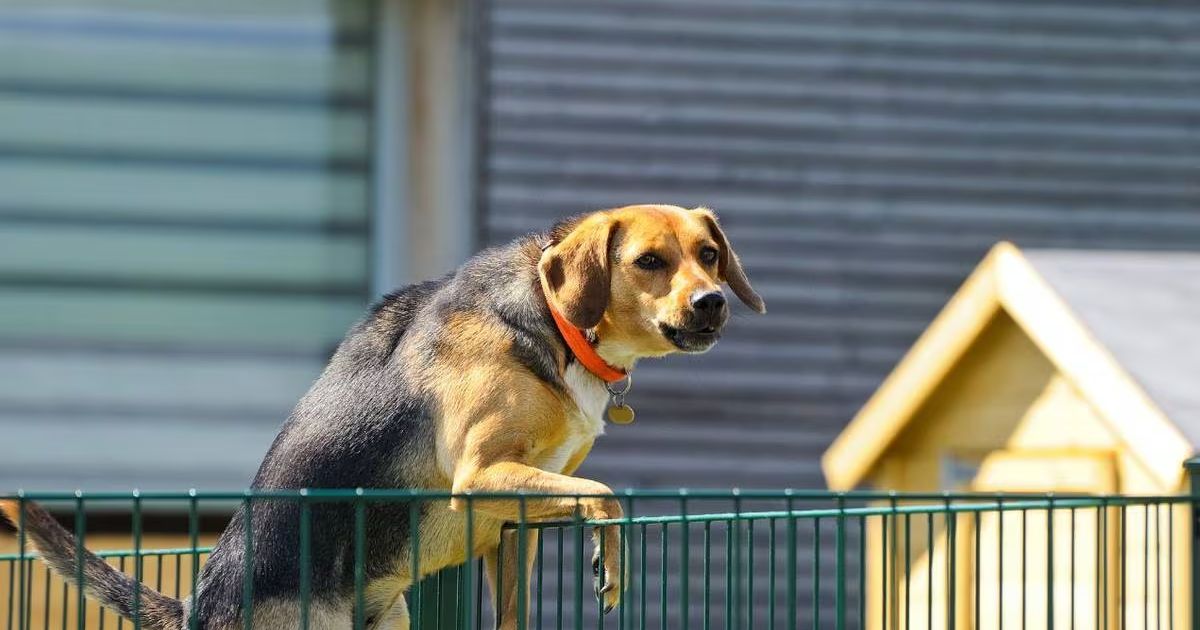Do you ever feel like your furry friend is on a mission to conquer the great escape? Well, fear not, because we have the solution to keep your pup from climbing that fence. Dogs are naturally curious and adventurous creatures, seeking a sense of belonging within their surroundings. By understanding their motivation and reinforcing boundaries, you can create a safe and secure environment for your beloved companion. In this guide, we will explore various techniques, from training and mental stimulation to physical barriers and alternative enclosures. Remember, you are not alone in this journey. Together, we can help your dog feel content and confident, and ultimately, keep them from scaling that fence. Let’s get started!
Key Takeaways
- Observing your dog’s body language and behavior is essential to determine the underlying cause of fence climbing.
- Addressing fear and anxiety through positive reinforcement training, desensitization, and counter-conditioning can help redirect your dog’s behavior.
- Establish clear boundaries and set physical barriers, such as fences or gates, to prevent climbing.
- Engage your dog with mental and physical stimulation to prevent fence climbing.
Understanding the Motivation
First, you need to understand why your dog is motivated to climb the fence. Understanding canine behavior is crucial in addressing this issue effectively. Dogs may climb fences out of fear and anxiety, seeking escape or a sense of security. It is essential to observe your dog’s body language and behavior to determine the underlying cause. Fearful dogs may be trying to escape perceived threats, while anxious dogs may be seeking comfort or reassurance.
Reinforcing Boundaries and Training
To effectively address the issue of your dog climbing the fence, reinforcing boundaries and training are key. Here are four important steps to help you with boundary reinforcement and obedience training:
- Establish clear boundaries: Clearly define the areas where your dog is allowed to go and set physical boundaries, such as using fences or gates, to prevent climbing. Consistency is crucial in reinforcing these boundaries.
- Teach the “off” command: Train your dog to understand and respond to the command “off.” This will help discourage climbing behavior by teaching them to stay off the fence.
- Provide mental and physical stimulation: A well-exercised and mentally stimulated dog is less likely to engage in fence-climbing behavior. Make sure to provide daily walks, playtime, and interactive toys to keep your dog entertained and tired.
- Seek professional guidance if necessary: If your dog’s climbing behavior persists despite your efforts, consider reaching out to a professional dog trainer or behaviorist for additional guidance and support.
Providing Mental and Physical Stimulation
To prevent your dog from climbing the fence, it is important to provide them with adequate mental and physical stimulation. Engaging dog toys can keep their mind occupied and help redirect their energy away from fence climbing. Interactive training exercises, such as obedience training or agility courses, can also provide the physical activity and mental stimulation your dog needs to deter them from attempting to climb the fence.
Engaging Dog Toys
Keep your dog entertained and mentally stimulated with engaging dog toys that provide both mental and physical stimulation. Here are four options to consider:
- Dog Puzzle Toys: These toys challenge your dog’s problem-solving skills and keep them busy for hours. They often involve hiding treats or toys inside, encouraging your dog to use their intelligence to figure out how to retrieve them.
- Chew Toys: Dogs have an instinct to chew, and providing them with appropriate chew toys helps redirect their chewing behavior away from your furniture or belongings. Look for durable toys made of safe materials that can withstand your dog’s chewing.
- Interactive Toys: These toys require your dog to actively engage with them, whether it’s pushing buttons, pulling levers, or solving puzzles. They provide mental stimulation and help prevent boredom.
- Treat-Dispensing Toys: These toys are designed to hold and dispense treats as your dog plays with them. They keep your dog entertained and motivated, as they work to get the hidden treats out.
Interactive Training Exercises
Engaging your dog in interactive training exercises can provide both mental and physical stimulation, helping to prevent boredom and promote a healthy, happy dog. Training techniques that incorporate positive reinforcement are highly effective in teaching your dog new skills and behaviors. These exercises not only provide mental stimulation but also help strengthen the bond between you and your furry friend.
One example of an interactive training exercise is teaching your dog to fetch. Start by using a favorite toy and reward your dog with treats and praise when they bring it back to you. Another exercise is teaching your dog to do tricks like sit, stay, or shake hands. These exercises not only keep your dog physically active but also engage their mind, making them more content and less likely to engage in unwanted behaviors like fence climbing.
Utilizing Physical Barriers and Obstacles
To prevent your dog from climbing the fence, there are a few key points to consider. First, evaluate the height of your fence and make sure it is tall enough to deter your dog from attempting to climb over. Additionally, you can add deterrents such as coyote rollers or anti-climbing devices to make it more challenging for your dog to gain traction. Lastly, consider incorporating obstacles like plants or decorative elements near the fence to create a physical barrier that discourages climbing.
Fence Height Limitations
If you’re struggling with a dog that keeps climbing your fence, one effective solution is to incorporate physical barriers and obstacles that limit the height of the fence. Here are four fence height limitations that you can consider:
- Install a topper: Attach a trellis or mesh to the top of your existing fence. This will make it difficult for your dog to gain a foothold and climb over.
- Add extension arms: These are metal arms that extend from the top of the fence at an angle. They create an overhang that prevents your dog from easily scaling the fence.
- Use coyote rollers: These are spinning bars that can be installed on top of your fence. When your dog tries to climb, the rollers will spin, making it impossible for them to gain traction.
- Consider a higher fence: If all else fails, you may need to invest in a higher fence to prevent your dog from climbing over.
Adding Deterrents and Obstacles
To prevent your dog from climbing the fence, you can incorporate physical barriers and obstacles by adding deterrents and obstacles that create a more challenging climbing environment. One effective deterrent is the use of PVC pipe or chicken wire along the top of the fence. Attaching these materials at an angle, makes it difficult for dogs to gain a foothold and climb over.
Another option is to install a coyote roller system, which consists of spinning rollers that prevent dogs from gaining traction and climbing over the fence. It is important to strategically place these deterrents and obstacles in areas where your dog tends to climb. By doing so, you can maximize their effectiveness and minimize the chances of your dog successfully climbing the fence.
Exploring Alternative Outdoor Enclosures
You can consider exploring alternative outdoor enclosures as a solution to prevent your dog from climbing the fence. Here are four options to consider:
- Dog-proof fencing: Install a dog-proof fence that is specifically designed to prevent climbing. These fences typically have smooth surfaces and no footholds, making it difficult for dogs to climb over.
- Invisible dog fence: Consider using an invisible dog fence, also known as an underground or electric fence. This system uses a boundary wire buried underground and a collar that emits a warning sound or mild correction when your dog gets too close to the boundary.
- Outdoor dog kennel: Set up an outdoor dog kennel that provides a secure and controlled space for your dog to play and exercise. Choose a kennel with a sturdy construction and a roof to prevent escape attempts.
- Outdoor dog run: Create an outdoor dog run by enclosing a designated area with a tall and secure fence. This allows your dog to have some freedom to move around while still being contained.
Seeking Professional Help and Consultation
Consider reaching out to a professional for help and consultation in addressing your dog’s fence-climbing behavior. Professional trainers specialize in dog behavior and can provide valuable insights and guidance in dealing with this issue. They have the expertise and experience to assess your dog’s specific situation and develop a customized training plan for behavioral modification.
By working with a professional, you can gain a better understanding of the underlying causes of your dog’s fence climbing and learn effective techniques to prevent and discourage this behavior. Additionally, a professional trainer can teach you how to properly reinforce positive behaviors and discourage negative ones, promoting a strong and healthy bond with your furry friend. Seeking professional help can provide you with the support and knowledge needed to overcome your dog’s fence-climbing challenges.
FAQ’s
Why do dogs climb fences?
Dogs may climb fences out of curiosity, boredom, or a desire to explore beyond the enclosure. Some breeds are more prone to climbing behavior.
How do I stop my dog from messing up the fence?
Provide mental and physical stimulation, such as toys and regular exercise, to prevent boredom. Consider training and reinforcement for good behavior.
How do I keep my dog from getting out of the fence?
Ensure the fence is tall enough and has no footholds. Supervise outdoor time, and consider reinforcing the fence with dig guards at the base.
What can I put on my fence to stop dogs?
Use deterrents like bitter sprays or safe pet repellents. Add coyote rollers or cat-proofing devices on top of the fence to discourage climbing.
Conclusion
In conclusion, stopping a dog from climbing a fence requires understanding their motivation, reinforcing boundaries through training, providing mental and physical stimulation, utilizing physical barriers, exploring alternative enclosures, and seeking professional help if needed. Remember, “prevention is better than cure,” so take proactive measures to ensure your dog’s safety and prevent them from escaping. With patience, consistency, and the right techniques, you can effectively keep your furry friend from climbing fences and ensure their well-being.










